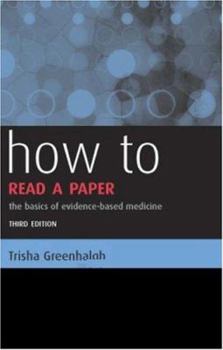How to Read a Paper: The Basics of Evidence-Based Medicine
Select Format
Select Condition 
Book Overview
Required reading in many medical and healthcare institutions, How to Read a Paper is a clear and wide-ranging introduction to evidence-based medicine and healthcare, helping readers to understand its... This description may be from another edition of this product.
Format:Paperback
Language:English
ISBN:1405139765
ISBN13:9781405139762
Release Date:January 2006
Publisher:Blackwell Bmj Books
Length:229 Pages
Weight:0.85 lbs.
Dimensions:0.5" x 5.2" x 8.8"
Customer Reviews
4 ratings
A lot of qualitative info to better assess quantitative medical research
Published by Thriftbooks.com User , 14 years ago
This is a very readable and informative book on how to read and assess medical research papers. The author touches on something broadly applicable to almost any field, and that is how to exercise critical thinking, how to ask the right questions, what logical traps to avoid. This is so doctors don't get fooled by eager pharmaceuticals representatives; Also, for patients to educate themselves in Bayesian statistics so they can overcome their doctors flawed tests recommendations. This book will also help researchers conduct their own experiment in integer ways to derive informative results for society at large. It will also help policymakers not being fooled by flawed research studies. The author has been criticized for not often technically describing the statistical tests she refers to. But, this was not the author's purpose. She states right upfront in the preface, if you want to dig deep into the technicalities get Clinical Epidemiology: A Basic Science for Clinical Medicine. The author has conveyed something more important than providing another treaty in statistical epidemiology. Frankly, if you are interested in the various statistical tests, Wikipedia will do just fine. But, what tests to use when and how are very important considerations she addresses with much expertise. What analytical framework and methodology to use in what research situation. How to judge if such research conducted by others used inappropriate frameworks. Those are tough issues often more difficult to handle proficiently than conducting statistical tests. She provides extensive information on related subjects. Her introduction to Bayesian statistics in chapter seven is really clear. She explains the likelihood ratio in the most straightforward way I have seen yet. Her chapter on economic analysis is surprisingly insightful as she defines all the different types of such analysis. Appendix I consists in a very rich set of checklists for finding, appraising, and implementing [medical] evidence. It is a good reference guide to the entire material within the book. Her chapter on statistics for the non-statisticians is outstanding. She actually teaches you a lot about statistics without going into the math. She even uncovers several traps that many professional statisticians may fall into especially when blinded by economic interests. Her discussion on distinguishing causation from correlation or regression is well thought out. In summary, this book offers a lot of valuable qualitative information to better interpret quantitative research for both the layperson and the expert alike.
Paulo Carvalho
Published by Thriftbooks.com User , 17 years ago
It is a concise and understandable book covering all that is important for concise critical appraisal of the literature on health and medicine. It is a very good start point for undergraduate and postgraduate students who want to get knowledge about this subject. I would like to remember you; if you can not do a critical appraisal of the paper you are reading probably you are buying cats thinking it is a rabbit...
Excellent EBM tool !!!
Published by Thriftbooks.com User , 17 years ago
If you want to learn about EBM in an objective, practical and friendly way, this book is an excellent tool.
Good guide to EBM
Published by Thriftbooks.com User , 22 years ago
Greenhalgh's book is a great read for someone familiar with medical and research terminology. As a med student, I loved it and found it very practical. It contains a great deal of material on how to evaluate the type, methodology, and statistical methods of research papers. There is no glossary, and in places the layout is hard to look at.





